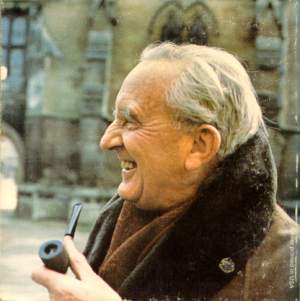Biography
![]()
Biography
|
John Ronald Reuel Tolkien was
born in Bloemfontein, South Africa on January 3, 1892 to Arthur and Mabel
Tolkien. Arthur was a banker and had moved to Africa for better job prospects,
but suddenly passed away in 1896. In the same year, Tolkien, his mother,
and brother Hilary moved back to the West Midlands in England. |
||
| Tolkien's mother,
a diabetic, fell ill and died in 1904, and so young John was sent to live
at a boarding house belonging to a Mrs. Faulkner. During this time, he began
to show an interest in philology, having mastered both Greek and Latin and
showing a profound interest in Finnish. He also showed interest in a young
woman lodging with Mrs. Faulkner as well, a young Edith Bratt three years
his senior. The local priest forbade Tolkien contact with Bratt for three
years, until he was 21; he followed that mandate religiously and promptly
proposed as soon as he was of age. They married in March 1916. Meanwhile,
he had enrolled at Oxford in 1911 and immersed himself in the Classics,
Old English, Germanic languages (esp. Gothic), Welsh, and Finnish.Tolkien
graduated from university in 1915, on the eve of World War I.
He did not rush to join up, but was drafted and eventually served four months
on the Western Front during the Somme offensive. However, Tolkien soon fell
ill to "trench fever," a typhus-like infection, and was removed
from active duty in November 1916. |
 |
|
| Around the same
time as the armistice was signed, Tolkien was appointed Assistant Lexicographer
on the Oxford English Dictionary in 1918. However, this sort of
work bored him, and he was thereafter appointed Associate Professor of
the English Language at the University of Leeds in 1920. During this time,
he collaborated with E.V. Gordon on his first serious translation Sir
Gawain and the Green Knight. His version was so successful that he
was eventually able to secure a post as Professor of Anglo-Saxon at Oxford
University in 1925.In moving to Oxford, Tolkien had come home, as he stayed
there until his retirement in 1969. Although rare, his scholarly publications
were extremely influential, the most famous of which was his expository
lecture Beowulf: The Monsters and Critics. While at Oxford, he also became
a member of a social group comprised of literary professors who met often
for conversation, drink, and readings from their works-in-progress. This
group became known as "The Inklings," and included such other
prominent writers as Owen Barfield, Charles Williams, and above all C.S.
Lewis, one of Tolkien's closest friends. Biography adapted from David Doughan at www.tolkiensociety.org |
||
![]()